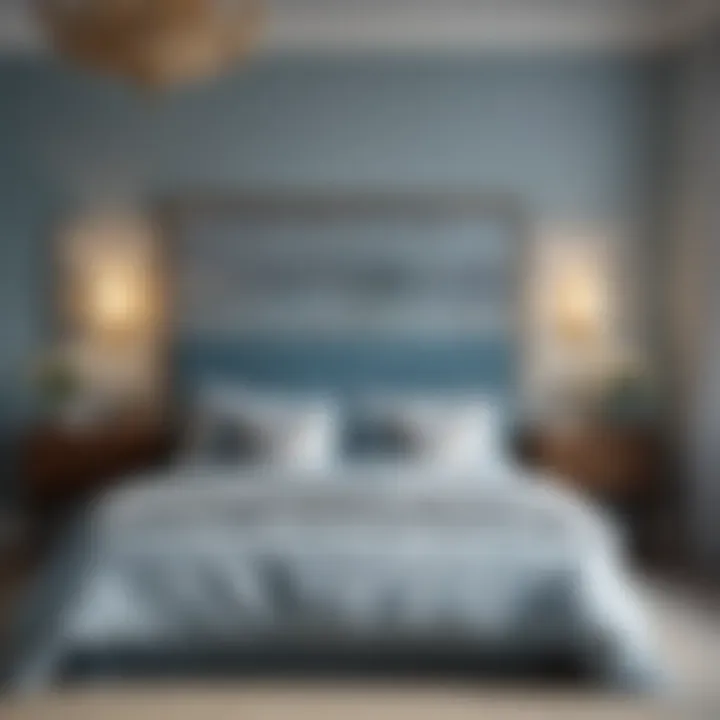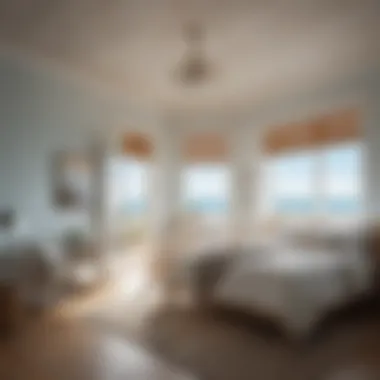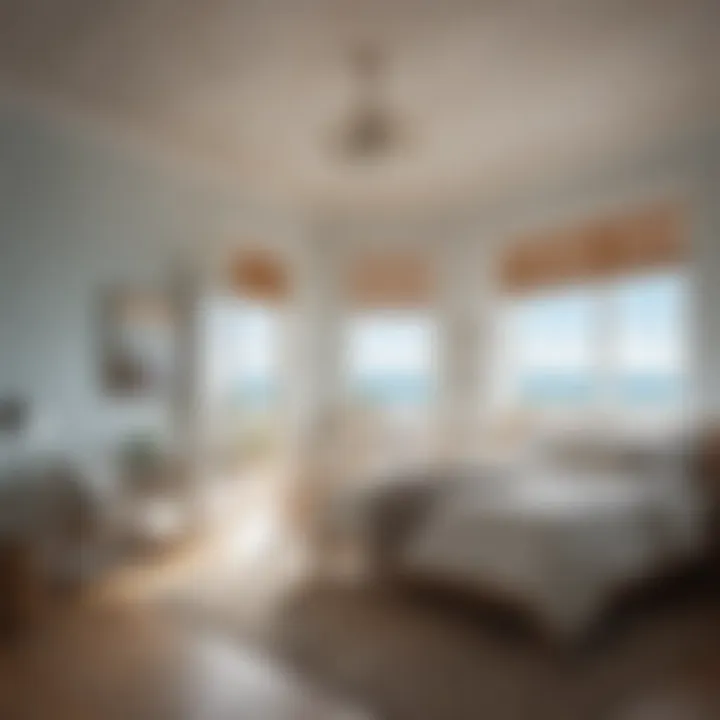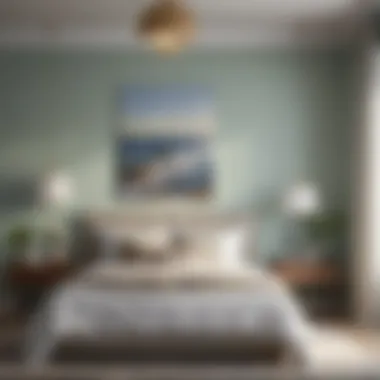Creative Beachhouse Bedroom Designs That Inspire Calm


Intro
Designing a beachhouse bedroom is more than just picking a few seashell-colored pillows and calling it a day. It involves deep thought about how to merge the essence of coastal living with a personal touch. By implementing smart strategies and selecting the right elements, you can create a space that resonates with tranquility while also being functional. This guide seeks to illuminate the various aspects that go into crafting a beachside haven, focusing on essential design principles, material choices, and color schemes that perfectly reflect the coastal environment.
Creating this retreat isn’t merely about aesthetics; it’s also about creating an experience that soothes the senses. Natural light plays a fundamental role here, and thoughtfully chosen furnishings can complement the serene backdrop of the ocean. With a keen eye for detail and understanding of your surroundings, you can turn your beachhouse bedroom into an idyllic escape that echoes the rhythm of the waves.
Trending Styles
When it comes to beachhouse bedrooms, trending styles can set the tone and mood. Two styles that have gained prominence in this sphere are Modern Minimalism and Cozy Rustic.
Modern Minimalism
This style emphasizes simplicity and functionality. Picture a sleek platform bed, crisp white linens, and the occasional accent of driftwood or coral. Less is definitely more here; the focus is on open space and light. Large windows allow sunlight to flood the room, accentuating the minimalist décor.
Incorporating pieces that serve dual purposes can also be a plus, making the best of limited spaces without sacrificing elegance. This style’s clean lines and uncluttered surfaces work especially well in a beachy setting, evoking a sense of calm that draws from the surroundings.
Cozy Rustic
On the contrary, Cozy Rustic embraces warmth and texture, perfect for those who want a more homely feel. Think reclaimed wood furniture, soft fabrics, and subtle ocean hues. Decor elements like woven baskets and linen curtains can add a cozy touch while maintaining that coastal vibe.
This approach can also incorporate vintage or heirloom pieces that tell a story, adding depth and charm to the bedroom. Throw blankets and cushions in earthy tones create inviting spots for relaxation.
"A well-designed bedroom can not only enhance your home but also your mental well-being. It reflects your lifestyle and preferences."
Color Palettes
Color can significantly influence mood and perception. Selecting an appropriate color palette is vital for translating your vision into reality. Two compelling directions to consider are Calming Neutrals and Bold Accents.
Calming Neutrals
Soft beiges, sandy whites, and gentle seafoam greens are key shades in this palette. These colors mirror the natural environment, creating a serene and soothing atmosphere conducive to relaxation. When combined with plenty of natural light, these shades can make a small bedroom feel larger and more open.
Utilizing textured materials like linen or cotton in these colors can add a layer of depth to the space. Picture soft white curtains fluttering in the gentle ocean breeze—this light and airy setup can make for a delightful start to your day.
Bold Accents
If you’re the adventurous type, consider integrating bold accents into your beachhouse bedroom. Rich blues reminiscent of deep ocean waters or vibrant corals can inject energy into the space. These dramatic tones work beautifully when incorporated into smaller elements—perhaps a piece of wall art, a statement throw, or decorative pillows.
By using bold accents wisely, you can create focal points that channel the energy of the seaside without overwhelming the senses. Just a pop of color can transform an otherwise neutral room into a vibrant retreat.
Understanding the Beachhouse Aesthetic
The concept of the beachhouse aesthetic is not merely about what meets the eye; it embodies a lifestyle and an emotional resonance that flows through every aspect of design and decor. When considering how to transform a bedroom in a beachhouse, understanding this aesthetic is crucial. It allows us to create a space that reflects the serene and refreshing qualities of the coastal environment.
Central to this design philosophy is the acknowledgment of how the setting shapes our feelings and experiences. A beachhouse isn't just a structure; it's an escape into nature, where sunlight dances off the waves and the salty breeze fills the air. Therefore, every design choice should echo these characteristics, promoting a sense of tranquility and comfort. This journey of exploration invites us to familiarize ourselves with two key aspects: the character traits of coastal living and the need for integration with nature.
Character Traits of Coastal Living
Coastal living exudes an effortless charm. Its character traits can be defined by simplicity, informality, and a down-to-earth quality that encourages relaxation. The essence of this theme brings to mind natural materials, airy designs, and a color palette reminiscent of sandy beaches and azure skies. Here are a few characteristics to consider:
- Natural Elements: Utilize materials sourced from the local environment, like driftwood, seashells, and even pebbles, to connect the space deeply with its surroundings.
- Casual Warmth: Opt for a laid-back vibe, making the bedroom inviting and cozy, as if welcoming a gentle ocean breeze inside. Balance modern aesthetics with rustic charm to steer clear from looking overly polished or fussy.
- Functional Spaces: Space should flow easily. The beachhouse should feature versatile areas that can accommodate various activities, from entertaining guests to enjoying a quiet moment alone.
Integration with Nature
Integrating the bedroom with nature goes beyond mere aesthetics; it embodies a lifestyle choice. By blending the interior with the external environment, one can create a seamless transition that enhances well-being. Here are ways to achieve this integration:
- Maximize Windows: Consider large, floor-to-ceiling windows or sliding glass doors that invite the outside in. This not only brings in natural light but offers stunning views of the surrounding landscape.
- Natural Ventilation: Embrace the coastal breeze. By strategically positioning openings, you can allow fresh air to circulate without relying heavily on artificial means.
- Include Natural Views: Design the layout so that the bed is positioned to face the ocean or the garden. This minor consideration can profoundly influence mood and energy levels.
"In the beachhouse, you don't just wake up; you rise with the sun, infused with the salty air and the rhythmic sound of waves."
By understanding the beachhouse aesthetic, you're setting the stage for innovative designs that reflect the beauty of coastal living. This foundation leads to thoughtful choices in color, materials, and furnishings that align with both comfort and style. The next step is to delve into design principles that will take your beachhouse bedroom from a mere collection of furniture to a harmonious retreat.
Design Principles for a Beachhouse Bedroom
Design principles play a crucial role when crafting a beachhouse bedroom that truly embodies the serenity and charm of coastal living. This section delves into essential elements that not only enhance the aesthetic appeal of the space but also promote functionality and comfort. By emphasizing simplicity and a well-planned layout, homeowners can create a sanctuary that reflects the beauty of the beach while ensuring practicality for daily use.
Benefits of adhering to thoughtful design principles:
- Encourages relaxation: A harmonious space helps in unwinding after long days.
- Enhances visual appeal: Thoughtful design adds character and style.
- Facilitates better organization: Practical layouts help in maintaining an uncluttered environment.


Understanding and applying these principles create a cohesive environment where the beach vibe flows seamlessly in the bedroom.
Simplicity Over Complexity
When one thinks of a beachhouse bedroom, a sense of calm and openness usually comes to mind. This image is achieved through the principle of simplicity. Choosing fewer but meaningful elements can lead to a coherent design that invites peace rather than chaos.
The essence of simplicity can be highlighted in the following ways:
- Fewer furnishings: opt for a bed, perhaps a bedside table, and limited decor. The goal is to avoid overcrowding, allowing more floor space for movement.
- Minimalistic decor: Wall hangings or paintings should evoke maritime themes without overwhelming the senses. Nautical stripes or subtle ocean colors may adorn the walls or quilts, keeping the ambiance fresh while staying rooted to the beach theme.
- Natural light: Keeping window treatments light (think sheer curtains) enables the lovely sun to stream in, enhancing the overall brightness while maintaining connection to the outside world.
A clean and uncluttered space not only looks inviting but also promotes a feeling of tranquility, making it easier to enjoy moments of solitude or intimate gatherings.
Functional Layout Considerations
When designing a beachhouse bedroom, a functional layout is paramount. It should cater to both daily usage and occasional escapes for rest and relaxation. Properly planning the layout can enhance the flow of the space, making it both livable and visually appealing.
Key aspects to consider when planning the layout include:
- Room size and shape: The dimensions of the room are essential in determining the placement of beds, dressers, and other furniture. A rectangular room, for example, can benefit from placing the bed against the longest wall, creating a balanced look.
- Zoning: Create distinct zones for different activities, like sleeping, reading, or dressing. A small reading nook can be set up by a window.
- Furniture spacing: Ensure there’s enough space to move around. A good rule of thumb is to maintain at least two feet of clearance between pieces, particularly around the bed.
In summary, a functional layout is not only about aesthetics; it also fosters an environment that promotes ease of use and enhances the overall experience of the beachhouse bedroom, resulting in a space where anyone can comfortably unwind.
"Simplicity is the ultimate sophistication." - Leonardo da Vinci
Taking time to understand and implement these design principles can significantly improve the coastal bedroom experience, yielding a haven that reflects the beauty of nature while providing a comfortable retreat.
Choosing the Right Color Palette
When designing a beachhouse bedroom, the choice of color palette is like the foundation of a sturdy house; it sets the tone for everything that follows. The right colors help to evoke feelings of tranquility, connect the space to its coastal surroundings, and create that inviting retreat out of the hustle and bustle of daily life. Using a thoughtful and intentioned color scheme can make a world of difference in how a space feels—a pastel shade or a bold hue can either lift the spirits or overwhelm the senses.
Influence of Light and Space
Light plays a major role in color perception. Coastal bedrooms often take advantage of natural light, and choosing colors that complement this can elevate the experience. Light, airy shades such as soft whites, sandy beiges, or muted blues brighten up the room, giving it a sense of openness and freedom.
- Consider the way light enters the room: South-facing windows flood a room with sunlight, making warmer colors appear more intense. Conversely, cooler light from the north can soften more vibrant hues.
- Use mirrors strategically: Placing mirrors across from windows can multiply the effects of natural light, enhancing the colors you've chosen.
Bright, reflective colors can mimic the shimmer of ocean water, while deeper tones might ground the room like rocks on the shore, providing a balanced aesthetic. A key takeaway is to test paint samples at different times of the day before making a final choice—colors can shift dramatically with changing light.
Oceanic and Earthy Tones
With a beachhouse being so intrinsically linked to nature, drawing inspiration from oceanic and earthy tones creates a harmonious environment. These colors not only resonate with the surroundings but also bring the essence of the outdoors inside.
- Oceanic tones include various shades of blue, teal, and even soft greens. These colors can create a soothing atmosphere reminiscent of the sea.
- Earthy tones, like sandy browns, muted terracotta, and warm grays, can ground the space, offering solidity.
Incorporating bold hints of coral or seafoam green can act as beautiful accents, embodying the vibrant life beneath the waves. Generally, the idea is to find a blend that captures the essence of coastal living—a serene retreat that feels fresh yet grounded.
Material Selection for Comfort and Durability
When designing a beachhouse bedroom, selecting the right materials plays a vital role in achieving a serene and enduring space. Comfort and durability are not just desirable traits; they are necessities that ensure your sanctuary remains inviting and functional over the years. With the challenges posed by coastal living, choosing materials that can withstand the elements while providing coziness is paramount. A thoughtful approach to material selection enhances the overall aesthetic, and even influences the mood within the room.
Natural Fibers vs. Synthetic Materials
In the realm of textiles, a decision often arises between natural fibers and synthetic materials. Natural fibers like cotton, linen, and jute are favored for their breathability and softness. They allow for air circulation, making them ideal for warm beach climates. Imagine slipping into a bed with cool, crisp cotton sheets after a day under the sun; it’s pure bliss.
On the flip side, synthetic materials such as polyester and nylon bring durability to the table; they resist fading and can endure rigorous washing. However, the comfort level is sometimes sacrificed, especially in hot environments where heat retention can become a nuisance. Many savvy homeowners have struck a balance by mixing these materials. For instance, a cotton duvet paired with a polyester comforter provides warmth without overheating.
Pros and Cons
- Natural Fibers:
- Synthetic Materials:
- Pros: Breathable, soft, and often hypoallergenic
- Cons: May require more upkeep and aren't as fade resistant
- Pros: Durable, fade-resistant, and often easier to clean
- Cons: Can feel less natural and tend to retain heat
Water-Resistant Options
Water-resistant materials are essential for beachhouse bedrooms. With the close proximity to the ocean, exposure to moisture is inevitable. It’s wise to consider materials that resist mold and mildew, particularly for bedding and upholstery. For example, performance fabrics such as Sunbrella are engineered to combat the effects of humidity and are perfect for coastal retreats.
These materials are designed with water repellency in mind, making them ideal for families. Imagine having a joyous summer with friends coming over, and a drink spills on the sofa—no worries! With water-resistant fabrics, cleanup is a breeze.
Additionally, selecting treated woods for furniture ensures longevity even in high humidity. Teak and cedar are excellent choices, known for their natural oils that resist water absorption. In this way, the beachhouse bedroom remains a cozy yet practical place, regardless of the nearby waves.


"The right materials are like the secret sauce to a perfect recipe; they enhance the dish and make it stand out."
Furnishing a Beachhouse Bedroom
Furnishing a beachhouse bedroom isn’t just about finding the right pieces to fill a space; it’s about creating an ambience that harmonizes with the sea and sky outside. When embarking on this journey, it’s crucial to consider not just aesthetics, but also functionality, comfort, and the overall vibe one wishes to evoke in the room. An effectively furnished bedroom can reflect the serenity of coastal life, turning a simple room into a soothing retreat.
Selecting the Right Bed Frame
The bed frame serves as the centerpiece of any bedroom. When selecting the right one for a beachhouse bedroom, one should look for frames made from materials that not only stand the test of time but also resonate with the coastal theme.
- Wooden Frames: Opting for driftwood or light-colored woods can enhance that seaside feel. A weathered finish can evoke the charm of beach cottages, connecting indoor spaces with the exterior environment.
- Metal Frames: Sleek, minimalist metal options can create a contemporary contrast against the soft textures of a beach setting. Think of embracing metallic finishes that mimic the hues of sandy shores.
It’s also key to consider height and size. A height that allows for easy access while maintaining a cozy atmosphere is essential, especially in spaces where ceilings may feel less spacious. Ultimately, choosing a bed frame that complements your personal taste while fitting seamlessly into the coastal aesthetic will provide both comfort and style.
Incorporating Versatile Storage Solutions
In a beachhouse bedroom, the necessity for storage can easily be overlooked amidst the quest for a relaxed design. However, ample storage is vital to maintain the airy feel of the room and keep it clutter-free.
Some clever storage ideas include:
- Under-Bed Drawers: This choice allows for easy access to seasonal clothing or linen, granting more space without sacrificing aesthetics.
- Floating Shelves: Great for displaying small decorative items or books, shelves add a touch of personal flair while being practical. They can be positioned above furniture like beds or dressers, ensuring that the design remains outwardly simplistic.
"Furniture should be functional as well as beautiful. It should hold its own weight in the room while also floating the essence of its environment."
Consider multi-functional pieces, such as ottomans that double as storage, or bedside tables with drawers and open space for organized visibility. This approach not only uses space wisely but also enhances the coastal experience by maintaining an open, airy environment in the bedroom.
To truly achieve that beachhouse vibe, each piece of furniture selected should not only serve a purpose but also contribute to an overall atmosphere of relaxation and tranquility. Each choice made in furnishing is another step toward creating that serene coastal retreat.
Emphasizing Natural Light
Natural light plays a vital role in creating an inviting beachhouse bedroom. Not only does it enhance the overall aesthetic, but it also boosts mood and promotes well-being. The right blend of sunlight streaming through will help highlight color choices, textures, and the overall design vibe of the room. It’s like adding a touch of magic; the rays dancing across surfaces can transform the ordinary into the extraordinary.
Window Treatment Options
When considering how to incorporate natural light, window treatments are the unsung heroes. They can either launch the light in or shackle it down. For a beachhouse, light, airy fabrics are an ideal choice. Think sheer curtains that billow gently in the sea breeze, allowing filtered sunlight to create a soft glow within the space. Fabrics such as linen or cotton not only look great but also stay functional in a moist environment.
Additionally, you might want to explore options like roller shades or bamboo blinds. These can provide privacy without completely blocking out the sun. While the sun can sunbathe the room, it's essential to ensure that the furnishings are protected from direct sunlight that could fade them over time.
- Light-filtering shades: Allow soft light while still offering privacy.
- Sheer drapery: Enable a breezy flow and keep the coastal vibe alive.
- Wooden shutters: Provide a rustic beachy touch and full control over light levels.
- Curtains with tie-backs: Allow an easy transition from full light to partial coverage.
Strategic Furniture Placement
Next up, let’s talk about furniture placement, an art and science all rolled into one. The aim is to maximize the natural light and ensure it permeates all corners of the room.
Positioning your bed in a way that it catches the morning sun can set a positive tone for the day. That spot near the window might just become your go-to area for basking in the sunlight while scrolling through your morning emails or sipping a cup of coffee. A side table with a lamp can be set close by to make nighttime reading cozy and enchanting.
Furthermore, avoid heavy furniture blocking light sources. Instead, use lighter materials for pieces that anchor the room. A glass-topped coffee table or shelving made from driftwood can maintain space's airy feel and reflect the sunlight beautifully.
"The right positioning not only enhances light flow but also encourages easy movement and connection within the space."
Incorporating Ocean-Inspired Decor
When it comes to designing a beachside sanctuary, the use of ocean-inspired decor becomes a crucial aspect of creating a harmonious space that resonates with the coastal environment. It's not just about aesthetics; these decorating choices can evoke a sense of tranquility and bring a piece of the outside world into your bedroom. Incorporating elements from the sea can transport you to a serene place while blending beautifully with the overall beachhouse aesthetic.
The primary benefit of integrating ocean-inspired decor is the emotional connection it fosters. Surrounding yourself with bits and pieces that reflect the ocean—think coral motifs, starfish designs, or wave patterns—can instantly lift your spirits. This decor not only feeds into the design but also establishes a calming atmosphere, allowing you to unwind after a long day. It's like having a piece of the coastline to call your own.
Artwork and Personal Touches
Art is a powerful tool; it can set the tone of your space. Selecting artwork that echoes the colors and themes of the ocean is essential in achieving that cohesive look. Instead of opting for generic prints, seek original creations or local artists' pieces that capture personal significance. Nautical paintings, abstract ocean landscapes, or textured works that mimic sandy beaches or moving water can blend together to create a visual story.
If possible, incorporate personal touches — pictures from family beach vacations or even your children’s artwork. These elements ground the decor and infuse a touch of personal history. Here are a few considerations when selecting artwork:
- Local Artisans: Supporting local artists not only enhances your bedroom's character, but it also fosters a sense of community.
- Mixed Media: Combine different types of artwork; paintings, sculptures, or even woven pieces create a dynamic aesthetic.
- Framing: Choose materials for framing that blend with your furnishings. Driftwood frames, for instance, can add texture and authenticity.
Textures that Reflect Coastal Elements
Texture plays a weel-meaning role in the design. In a beachhouse bedroom, think about using materials that remind you of the shore. The feel of soft linens, rustic wood, or natural fibers creates an inviting ambiance while being reminiscent of the seaside. Consider these ideas to bring in coastal textures:
- Bamboo and Rattan: These natural materials can be incorporated into furniture and decor, giving a laid-back vibe.
- Linen and Cotton: Use light, breathable fabrics for bedding and curtains—nothing too heavy.
- Seashell Accents: Incorporating seashells into decor elements, such as lampshades or decorative bowls, adds a delightful whimsy.
- Rough Textures: Embrace unfinished wood or washed-out timbers for furniture to give that weathered look.


As you layer these textures, ensure they complement the color palette of your room. A rich blend of materials can transform your space into a genuine coastal retreat without overwhelming the senses. In the end, creating a balance between these elements might just give you that serene haven you’ve been craving.
Every piece you choose in your beachhouse bedroom should speak to your soul, connecting your living space to the spirit of the ocean.
Sustainable Practices in Design
Creating a beachhouse bedroom is not just about aesthetics; it’s crucial to consider how our choices impact the environment. Sustainable practices in design focus on reducing waste, conserving resources, and ensuring that the materials we use benefit both our living spaces and the planet. Embracing these practices can lead to a more serene space that aligns perfectly with the principles of coastal living.
Implementing sustainability can elevate the character of your bedroom. When utilizing sustainable materials, you’re not just building a home; you’re crafting a narrative that speaks of responsibility and mindfulness. This approach appeals to a growing crowd who care deeply about preserving the environment for future generations. Additionally, a sustainable design often leads to long-term cost savings due to durability and efficiency, making it not just an ethical choice but a wise one financially.
Recycled and Upcycled Materials
Making use of recycled and upcycled materials breathes new life into old items and minimizes waste. Incorporating furniture made from reclaimed wood can add a rustic charm, creating a unique vibe in your beachhouse bedroom. Imagine accent walls or headboards created from beach pallets. This method not only delivers an attractive rustic look but also tells a story of resilience and transformation.
- Wooden Pallets: Ideal for crafting bed frames or shelves, giving a casual and natural feel.
- Reclaimed Fabrics: Recover old sails or beach towels to make cushions or bedding. These textiles are often inherently durable and can withstand moisture.
- Salvaged Decor: Think old marine equipment transformed into lamps or art pieces. This is an excellent conversation starter.
Another effective method is to visit local thrift stores or flea markets, where treasures from different eras can be found. Seemingly mundane pieces can be transformed into focal points of the room. Not every piece needs to match; in fact, a curated mix can highlight the diversity of textures and styles.
"Using recycled materials not only enhances the personality of your beachhouse but helps conserve the beauty of the coast we cherish."
Energy-Efficient Lighting Solutions
Lighting holds immense power over the overall atmosphere of a room. In a beachhouse bedroom, where natural light plays a significant role, energy-efficient lighting can enhance the experience while helping to reduce your ecological footprint. LED lights are one of the best choices, providing versatility and longevity compared to traditional bulbs.
Consider these options:
- Dimmer Switches: They allow you to adjust brightness according to your mood and time of day, saving energy when full light isn’t needed.
- Smart Lighting: Integrate systems that can be controlled via smartphone, meaning you can manage energy use even when away from home.
- Solar-Powered Options: For outdoor spaces such as patios or balconies, solar lights can illuminate without consuming electricity from the grid.
By combining natural and artificial light sources, you can ensure your bedroom is well-lit while still maintaining an eco-conscious approach. Making the extra effort to select fixtures that complement the beachhouse aesthetic while being energy-efficient can lead to a harmonious balance between style and sustainability.
Creating a Relaxing Atmosphere
Creating a peaceful sanctuary in your beachhouse bedroom is not just a design choice; it's essential for fostering a sense of serenity amid the hustle and bustle of life. Several elements contribute to maintaining a tranquil vibe, allowing you to unwind and recharge after a long day. Central to this concept is a well-considered approach to decor and environmental qualities.
The beachhouse bedroom should embody an atmosphere that promotes relaxation, making it an inviting place to escape everyday stresses. The overall feel can be influenced by color schemes, furniture layout, and decor elements. Each piece contributes to how one experiences the space, both visually and emotionally.
Importance of Minimalism in Decor
Emphasizing minimalism in decor for your beachhouse bedroom brings clarity and calmness to the space. Clutter can be the enemy of peace; therefore, choosing to keep it simple often means selecting fewer, but more meaningful, elements. When the mind is free of excessive distractions, it's easier to immerse oneself in the beauty of the surroundings and appreciated the coastal charm.
- Choose functional furniture that is sleek and streamlined.
- Limit accessories that don’t serve a purpose. Instead, opt for a few carefully chosen pieces that resonate with your coastal theme.
- A neutral color palette with accents reflecting the ocean can unify the space, allowing your mind to relax.
Minimalism doesn’t imply bare and unappealing; it denotes a celebration of simplicity. This creates an open atmosphere, which, when paired with natural light, makes the bedroom feel airy and inviting.
Aromas and Soundscapes for Tranquility
Not everything is about what you see; the scents and sounds around you play a pivotal role in creating a soothing atmosphere. Aromas can trigger memories and emotions, which is a powerful tool in fostering relaxation. For instance, scents like sea salt, coconut, or vanilla can transport you directly to the coast, enhancing the beachhouse vibe.
When it comes to sound, incorporating natural soundscapes can transform your environment completely. Think of gentle ocean waves, rippling streams, or even a soft breeze rustling through trees. You could use a subtle sound machine or simply open your windows to let nature's melody drift in.
- Create a sensory experience: Combine elements of scent and sound for a full immersive environment.
- Essential oils in a diffuser can help in creating a calm atmosphere.
- A curated playlist with soft instrumental sounds can serve as perfect background music.
A cozy beachhouse bedroom isn’t just a place for rest; it’s an experience that nurtures your well-being. By focusing on minimalistic design elements and enhancing the environment with calming scents and sounds, you can craft a haven of tranquility that truly reflects the essence of coastal living.
Maintenance and Longevity of Beachhouse Bedrooms
Maintaining the charm and functionality of a beachhouse bedroom is crucial for long-term enjoyment. The relaxed coastal vibes are not just a fleeting trend but a lifestyle choice that calls for enduring elements. A well-kept bedroom reflects the harmonious relationship between the home and the surrounding nature. By focusing on maintenance and longevity, one can ensure that the serene escape remains inviting for years to come.
The seaside environment often comes with its own set of challenges. Factors like humidity, salt air, and sandy feet can wreak havoc on furnishings and decor. Choosing appropriate materials and integrating regular upkeep strategies can mitigate potential damages. Essentially, it's about preserving the beauty of your space while ensuring it’s functional and comfortable.
"Caring for your beachhouse bedroom is like nurturing a friendship—regular efforts make it flourish."
Choosing Durable Fabrics
Selecting fabrics that stand the test of time is paramount in a coastal bedroom. Opting for durable materials helps resist wear and tear while maintaining aesthetic appeal. Here are a few fabric types to consider:
- Canvas: This sturdy material handles a bit of rough and tumble, perfect for beach settings.
- Sunbrella: Known for its fade resistance, it’s ideal for allowing natural light without compromising colors.
- Microfiber: Easy to clean and maintain, this fabric stands up well against spills and stains.
- Bamboo: Eco-friendly and resilient, bamboo is not just sustainable but also adds a unique texture to the bedroom.
Choosing these fabrics ensures a cozy feel without the constant worry about deterioration. Furniture upholstered in tough textiles will keep your beachhouse bedroom looking fresh, even after countless sunny afternoons.
Seasonal Care Tips
Maintaining a beachhouse bedroom throughout the year requires a bit of foresight and planning. Here are some seasonal care tips to extend the life of your sanctuary:
- Spring Cleaning: As the seasons change, dust and debris can settle. A thorough cleaning of linens, curtains, and upholstery ensures a fresh start.
- Summer Ventilation: With higher humidity levels, keeping windows open allows for air circulation, preventing mildew build-up.
- Fall Inspections: Check for wear and tear on furniture and fixtures as you transition into cozier months. Ensure all items are secure and considered seasonal adjustments for comfort.
- Winter Protection: If you’re in an area that gets chilly, using protective covers for your furniture will help preserve their integrity until the warmer months return.
Incorporating these seasonal practices adds to the longevity of furnishings and decor while keeping the beachhouse bedroom a delightful sanctuary all year round.















